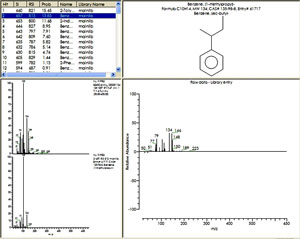Periodic testing of carbon samples from nuclear air cleaning systems sometimes shows that the carbon does not meet technical specification requirements and must be replaced. If that occurs in a short period of time, it is usually the result of organic vapors being permanently adsorbed by the carbon, which reduces the methyl iodide removal efficiency. To prevent reoccurrence, the source of the organic vapors must be known and removed. In order to determine the source, the compound must be identified.

NUCON now has the ability to perform Gas Chromatography; Mass Spectrometry (GCMS) analysis of activated carbon samples. It gives NUCON a tool to aid nuclear power plants in determining the root cause of failure of radioiodine carbon test samples.
NUCON has investigated the impact of different organic compounds and found that many of them can reduce the radioiodine removal efficiency of the carbon. Therefore it is important to discover and control the emission of organic vapors. Testing the carbon using the GCMS instrument can help do just that. For example, if the compound is identified as a chlorofluorocarbon, it is probably a refrigerant used in a chiller. If the material is identified as a solvent such as methylene chloride, toluene or perchloroethylene, it is coming from cleaning, degreasing, or paint stripping operations. If the materials are mineral spirits or glycol ethers, they have resulted from painting. Once the material is identified, the source can be determined and controlled in the future.
This laboratory capability is one more tool that NUCON provides to aid in eliminating events that can lead to interruptions in operation of air cleaning units.